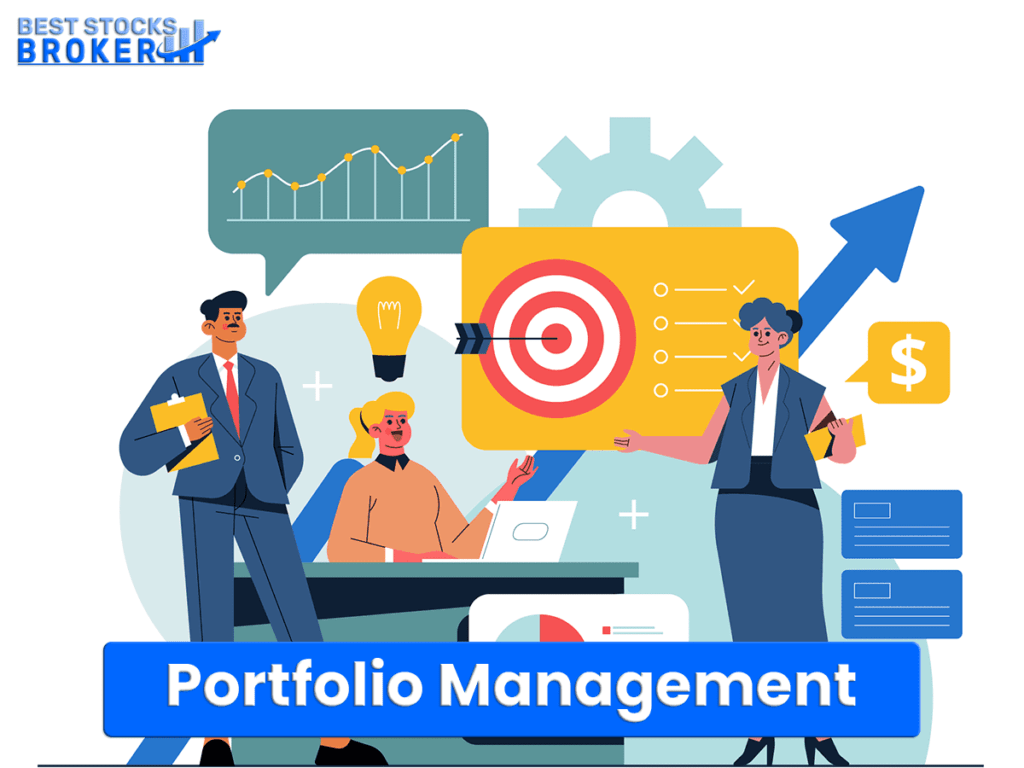What is Portfolio Management
Portfolio management is the process of investing in different assets like stocks, bonds, or other securities. This helps in spreading risk and aiming for better returns. Investors usually mix these securities in a way that suits their risk level and financial goals.
Portfolio management also involves deciding how to divide investments among different assets, choosing specific securities, managing risks, and regularly checking and adjusting the portfolio.

Table of Contents
Why Portfolio Management is Important
Here’s what makes Portfolio Management important:
1. Maximizing Returns
To maximize returns, making better decisions plays a vital role. Investment analysis gives detailed information about different investment opportunities. By knowing the risks and returns of different assets, investors can make better decisions and aim for higher returns.
Smartly allocating Funds helps develop the understanding of dividing investments among various asset classes. This helps in balancing high-risk, high-reward assets with safer, lower-return ones, which can optimize the portfolio’s performance.
2. Risk Management
Diversification is a key part of portfolio management. Diversification means spreading investments across different asset classes and securities. This reduces the impact of poor performance in any single investment.
Investment analysis involves checking the risks of various investments. Knowing the risk of each asset helps in making a portfolio that matches the investor’s risk tolerance.
3. Financial Goals
Both investment analysis and portfolio management focus on the investor’s financial goals. Whether the aim is growing wealth, generating income, or preserving capital, these processes ensure the portfolio is set up to meet these goals.
Portfolio management involves regularly checking and adjusting the portfolio. This ensures that the investments stay aligned with the investor’s goals and can be changed if needed due to market conditions or personal situations.
4. Adapting to Market Conditions
Understanding Market Trends allows investors to make proactive changes to their portfolios to take advantage of market opportunities or avoid losses.
Good portfolio management requires regular review and adjustment. By staying flexible and responsive to market changes, investors can protect their portfolios from significant losses and take advantage of new opportunities.
5. How can we Help
At HMA we have a lot of experience and use advanced tools for investment analysis and portfolio management, which can improve the performance of the portfolio.
We can also help in reducing the emotional decisions that individual investors might make. Decisions based on thorough analysis rather than emotions tend to yield better results.
Types of Investment
Before venturing forward into the different investment portfolio management, let us first understand where can one put his money into assets that can grow in value over time. Here are some types of investments explained from the most risk-carrying to the least risky type of investment regime.
1. Stocks
- Stocks are shares of a company that you can buy. When you own a stock, you own a small part of that company.
- If the company does well, the value of your stocks can go up, and you can make money. Stocks can be risky as they depend on a lot of fundamental and geopolitical factors.
- Stocks are suitable for growth-oriented portfolios.
2. Bonds
- Bonds are like loans that you give to companies or the government. They pay you back with interest over time.
- Bonds are usually safer than stocks and provide steady income.
- These are suitable for aged people who wish to rely on fixed income sources.
3. Mutual Funds
- Mutual funds are collections of stocks, bonds, or other investments managed by professionals.
- They make it easy to invest in many different things at once, which can spread out risk.
4. Real Estate
- Real estate means buying property like houses, apartments, or land.
- You can earn money through rent or by selling the property at a higher price later.
5. Savings Accounts
- Savings accounts are bank accounts where you can keep your money safe and earn a little interest.
- They are very safe, and you can take out your money anytime you need it.
6. Gold and Metals
- Investing in gold and other precious metals means buying these physical items.
- They can keep their value over time, especially when the economy is unstable.
Types of Portfolio Management
Portfolio management is about handling investments like stocks, bonds, and other securities to achieve financial goals while managing risks. There are different types of portfolio management. Here’s a simple explanation of the main types:
1. Active Portfolio Management
- In active portfolio management, the manager actively buys and sells securities to outperform the market or a specific benchmark.
- The manager does research, keeps an eye on market trends, and makes frequent changes to the portfolio.
- The main goal is to get higher returns than the market average.
2. Passive Portfolio Management
- Passive portfolio management aims to match the returns of a specific market index, like the Nifty 50 or Sensex.
- The manager creates a portfolio that mirrors the components of the chosen index and makes few changes over time.
- The goal is to achieve market returns with lower costs and less effort.
3. Discretionary Portfolio Management
- In discretionary portfolio management, the manager has full control over the investment decisions without needing the client’s approval for each trade.
- The manager uses their expertise to make decisions based on the client’s goals, risk tolerance, and market conditions.
- The goal is to provide personalized management to meet the client’s financial objectives.
4. Non-Discretionary Portfolio Management
- Non-discretionary portfolio management means the manager provides advice and recommendations, but the client makes the final decisions on investments.
- The manager suggests investments, but the client must approve all transactions before they are made.
- The goal is to guide clients while allowing them to remain in control of their investment decisions.
How to Manage Your Investment Portfolio
Managing your investment portfolio means looking after the different types of investments you have to make sure you’re getting the best results. Here are some easy ways to manage your portfolio:
1. Diversify Your Investments
- Do not put all your money into one type of investment. Instead, spread it out over different types like stocks, bonds, and real estate.
- This way, if one investment does badly, the others can still do well, and you won’t lose all your money.
2. Regularly Check Your Investments
- Keep an eye on how your investments are doing. Check them regularly to see if they are growing or not.
- If you see that some investments are not doing well, you can make changes to improve your portfolio.
3. Rebalance Your Portfolio
- Sometimes, you need to move your money around to keep the right balance of investments.
- This helps you stick to your plan and ensures that you’re not taking on too much risk.
4. Get Help from Experts
- What It Means: Ask for advice from people who know a lot about investing, like financial advisors.
- They can give you tips and help you make better investment decisions.
Having learned about the different types of asset classes and different ways of portfolio management. Let’s delve into the importance and the role of a portfolio manager:
Who is a Portfolio Manager?
A portfolio manager is a financial professional who is responsible for managing investment portfolios on behalf of individuals or companies. The primary role of a portfolio manager is to make investment decisions to meet the financial goals of their clients while also managing risks. Here is a few key points describing the role of portfolio managers and how their expertise supersedes any individual who makes investment decisions on his own
- A portfolio manager develops an investment strategy based on the client’s financial goals, risk tolerance, and time horizon.
- Based on his expertise, he decides how to distribute investments across different asset classes such as stocks, bonds, and real estate.
- His expertise in selecting specific securities which are based on fundamental, technical factors, economic conditions, and market conditions to include in the portfolio.
- A portfolio manager evaluates the risk associated with different investments and strategies.
- He ensures the portfolio is diversified to minimize risk and maximize returns.
- He continuously monitors the performance of investments to ensure they are meeting the client’s objectives.
- As per the market conditions, he makes necessary adjustments to the portfolio based on performance and other global scenarios.
- The most benefice aspect being working with a portfolio manager is you educate yourself about investment strategies and market trends that help you grow in confidence over future independent investments.
- As individual investors, we find it tough to scrutinize growing sectors or sectors or stocks that have a high probability of growing. A portfolio manager periodically rebalances the portfolio to maintain the desired asset allocation and risk level.
- All in all, a portfolio manager is a key player in the financial world. He can help us with our portfolio management which we as individuals may find tough keeping up with our routine jobs.
Portfolio management and the approach
Every individual has a unique financial goal and risk appetite. Financial portfolio management and managers take certain approach based on individual’s preferences. Here are a few portfolio approaches:
- Aggressive It involves investing in riskier assets to maximize earnings. This is a high risk high reward scenario where there is risk for potential higher losses.
- Conservative It involves investments in potentially safer assets where the priority is to preserve capital and to minimize risk.
- Moderate: This approach involves where a certain portion of investment goes into riskier assets and certain portion into less risky assets.
- Income-Oriented: This approach is suitable for those who are seeking a regular income. Dividend based assets and fixed schemes like bonds where one gets regular interest payouts. The major beneficiaries under this strategy are retirees.
- Tax-Efficient: The main aim is to minimize taxes. Those with a long time investment horizon are much suited to this kind of investment approach.
Conclusion
Having learned so much about portfolio management, about risk management, diversification and rebalancing and the different asset classes, it not only brings us to a conclusion but also opens a wide array showing the importance of portfolio management and portfolio manager who plays a key role in investment strategies.
Portfolio management involves decision making which may optimize returns while managing risk. Similarly, a skilled portfolio manager would work on selecting and monitoring investment approaches.
The expertise of a qualified portfolio manager and a sound portfolio management does provide a robust and a fruitful way to meet your investment goals and creating wealth.
FAQs – Portfolio Management
What is Portfolio Management?
Portfolio management is the process of investing in different assets like stocks, bonds, or other securities. This helps in spreading risk and aiming for better returns. Investors usually mix these securities in a way that suits their risk level and financial goals.
Portfolio management also involves deciding how to divide investments among different assets, choosing specific securities, managing risks, and regularly checking and adjusting the portfolio.
Why is Portfolio Management important?
Portfolio Management is important because it helps in maximising returns, manage risks, achieve financial goals and adapt to market conditions. Portfolio Management ensures that investments are diversified and aligned with the objectives of the investor.
What are the different types of Portfolio Management?
The different types of Portfolio Management are- active portfolio management, passive portfolio management, discretionary portfolio management, non- discretionary portfolio management. The approach to each type of portfolio management varies as per investment decisions, level of manager involvement and goals.
How can I manage my investment Portfolio?
Managing your investment portfolio means looking after the different types of investments you have to make sure you’re getting the best results. Here are some easy ways to manage your portfolio:
1. Diversify Your Investments
Do not put all your money into one type of investment. Instead, spread it out over different types like stocks, bonds, and real estate.
This way, if one investment does badly, the others can still do well, and you won’t lose all your money.
2. Regularly Check Your Investments
Keep an eye on how your investments are doing. Check them regularly to see if they are growing or not.
If you see that some investments are not doing well, you can make changes to improve your portfolio.
3. Rebalance Your Portfolio
Sometimes, you need to move your money around to keep the right balance of investments.
This helps you stick to your plan and ensures that you’re not taking on too much risk.
4. Get Help from Experts
What It Means: Ask for advice from people who know a lot about investing, like financial advisors.
They can give you tips and help you make better investment decisions.


